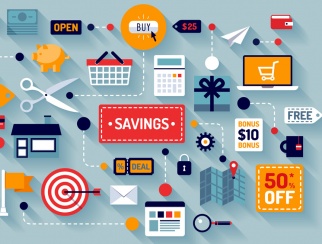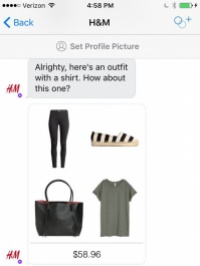On the election night last month crystal balls shattered from coast to coast, proving once again that making predictions is not for the faint of heart. Still, it’s become a tradition at STORES to put a stake in the ground and make some educated guesses about how the coming year is likely to unfold.
2017 will be a tipping point for many of the technologies that have been in startup mode for two to three years. That’s not to say that concepts such as artificial intelligence and virtual reality are ready for prime time, but clearly we’re at a point where these emerging technologies have proven valuable and are on the cusp of sparking greater change.
We’ve also reached an inflection point in the expectations of consumers and how they want to interact with brands and retailers. Shoppers expect brands to understand what’s important to them. They want and demand trust; if they have a problem, they expect answers. Connecting with today’s shopper implies understanding the fierce urgency of now that prevails in their lives. For retailers, that means being prepared to adapt quickly and transform processes when needed. Shoppers can be a punishing crowd; get on their bad side and you’ll suffer.
Innovation is imperative in today’s “what’s next” climate. That doesn’t necessarily imply an overhaul, but it does suggest the need for regular, impactful changes and a vigilant eye on the future.
What do we anticipate for the retail industry in 2017? This latest list of prognostications is based on months of listening and note taking and hours of thinking deep thoughts. Every conference session, exhibit hall meeting and phone briefing was fodder for determining what may be on the horizon. Thank you to all who shared their insights, took the time to teach us about new technology or set aside a few minutes to share their visions about where retailers will be focusing their energy in the coming year.
Machine learning will revolutionize retail
Machine learning is a branch of artificial intelligence capable of processing mounds of data to discover patterns that can later be used to analyze new data. Best of all, it gets better over time.
What does that mean for retailers, who for years lamented their inability to process the avalanche of data they were accumulating? They can now identify specific areas of focus. The frustration merchants face about not being able to distill value from data quickly enough to drive business performance will be reduced by the speed and accuracy of these neural networks. And while a certain amount of future planning will always be intuitive, machine learning enables retailers to peek into the future, simulate scenarios and predict outcomes.

Visual Match uses deep learning to make it easier for Houzz shoppers to discover products and materials.
Machine learning can also strengthen the reach of big data analytics and bring companies closer to the ideal of getting the right information to the right people at the right time. That’s not to say it’s magic; some things remain too complex to predict. Forward-thinking IT experts need to be immersed in machine learning and recognize its potential to shape the future of personalization and to inform and enhance the consumer experience.
Several retail companies are already applying machine learning. Macy’s On-Call is powered by IBM Watson’s machine learning and cognitive computing technology to assist shoppers as they wander through Macy’s department stores. The 10-store test enables shoppers to type in questions; Macy’s On-Call returns the top answer for that question, along with location-specific details.
The North Face is leveraging Watson’s natural-language processing machine learning system. It recently launched the Expert Personal Shopper intended to help outdoor enthusiasts find the perfect jacket for their next adventure.
In a somewhat different application, Houzz has developed Visual Match, a service that uses deep learning to make it easier for shoppers to discover and buy the types of products and materials that inspire them in the tens of thousands of photos contained on the platform.
No silos, boundaries or channels
Industry experts and pundits are determined to eliminate the word “omnichannel” from the retail lexicon and to break the habit of referring to ecommerce and mcommerce as separate business channels. Don’t expect huge strides on this front in 2017 — the real challenge is to concentrate on shoppers’ definition of commerce. That has nothing to do with channels or silos and everything to do with delivering great product, on time, at a fair price.

Consumers expect a seamless shopping experience that shifts smoothly from digital to physical stores. They want retailers to remember what they buy — a stepping stone to facilitating replenishment, and they want a touch of personalization — which translates into “know what I’m looking for, but don’t creep me out.” If you tell them the item is in stock, it needs to be in stock; excuses about disparate systems that don’t communicate with each other won’t fly.
It’s a mighty tall directive, one that few retailers are likely to accomplish in the next 12 months. Still, those who make technology investments aimed at improving inventory visibility and deploy order management systems that support a “buy, fulfill and return anywhere” strategy can make bold strides toward that goal. Accurate inventory visibility across the enterprise has been called the “single most important technology enabler” by RSR Research. Getting the inventory right assumes the ability to distill actionable insights from big data, overlay demand planning and manage supply chain visibility.
The industry has been talking about the “order management imperative” for years, stressing its critical role in nurturing a loyal customer base. It’s fair to say that it’s never been more crucial because shoppers demand transparency, trust the Internet and will turn their backs forever on brands that disappoint them.
Bet on bots and conversational commerce
Ignore the buzz around chatbots and conversational commerce at your own peril. This is not a passing trend; it’s a tool retail businesses can use to boost customer service and have more meaningful conversations with customers. Conversational commerce is the principal technology comprising chat, messaging or other natural language interfaces. It short-circuits the brand-to-consumer loop, facilitating “conversations” between people, brands or services and making it possible to use a device, notably a smartphone, to ask questions, place orders and get advice.

Chatbots are a subset of artificial intelligence, and they are becoming more popular, though challenges remain in simulating human qualities and the ebb and flow of everyday conversations. Chief among the challenges that data scientists face is the need for chatbots to access and retrieve huge amounts of data. To the shopper looking for information about the availability of a blue-striped shirt, it’s just a question, yet delivering an accurate response requires building — and quickly retrieving information from — massive data sets.
One early adopter, 1-800-Flowers, introduced its chatbot in the spring. The bot, which provides both human and automated options for customer service, allows users to order flowers and gifts. Thus far, 70 percent of the company’s chatbot orders have come from new customers, who generally skew younger than typical customers.
H&M’s chatbot, part of Kik’s Bot Shop, suggests various outfits to users and provides a chance to make a purchase through the bot’s messaging platform. Sephora is using a bot to provide beauty advice and product tips, and Pizza Hut and Domino’s are testing the waters with bots that facilitate pizza orders with just a few text-based commands. And just last month MasterCard announced that it is developing bots for both merchant and bank partners that will use chat, messaging and natural language interfaces to communicate with consumers.
Out-of-the-box collaboration
Grandin Road, a retailer of home décor products, launched its first-ever retail concept store this fall inside Macy’s Herald Square flagship in Manhattan. Complete with magical, mysterious accessories and enchanting décor, the shop was designed to inspire, spook and entertain Macy’s visitors. It also turned out to be a wickedly good partnership.
Non-traditional partnerships and collaborations represent new opportunities for retailers to explore ways to surprise and delight shoppers with unexpected products and experiences. How can a company offer new value to shoppers? It’s a matter of leveraging what you know about your customer and working to create compelling events and partnerships that complement your retail strategy and extend brand reach.

A partnerships between MAC Cosmetics and the Star Trek franchise acknowledges Star Trek’s history of strong female characters.
Target has offered limited-edition collections for years, connecting with upscale designers to provide capsule assortments for their fashion-savvy yet value-sensitive shoppers (Victoria Beckham will debut in April). The next generation of collaboration is unfolding with partnerships such as the one between MAC Cosmetics and the Star Trek franchise. Acknowledging Star Trek’s history of strong female characters and storylines that have pushed gender and racial boundaries, the edgy brand created what it described as a “transcending, transformational makeup collection.”
Another compelling collaboration took place during the back-to-school selling season. Personal stylists at Stitch Fix partnered with Gymboree to build children’s outfits that would take the guesswork out of determining what goes with what — and hopefully make moms’ mornings easier. Stitch Fix stylists created “bundles” of items from the Gymboree collection that worked well together, and the outfits were featured on the Gymboree website: Moms didn’t have to sign up for Stitch Fix to get a glimpse of the value of stylist-chosen.
Time to tune in to TV shopping
With retailers and consumers utilizing multiple digital platforms, TV may seem old school. Announcements made over the last few months, however, suggest that some retail innovators see TV as an opportunity to drive business and raise the bar in the quest for seamless shopping experiences.

QVC debuted a stand-alone channel called BeautyiQ in November. Dedicated solely to cosmetics, fragrances and skincare, the channel is available in 40 million homes on providers such as DirecTV and Dish.
In October, Wayfair and A&E Television Networks announced a new TV series that blends two of the nation’s favorite pastimes: watching TV and online shopping. Believed to be the first “fully shoppable” show, the hour-long “The Way Home” features do-it-yourself renovations and home improvements using products exclusively available from Wayfair. Every item that appears on the show is available for purchase, and on-screen pop-ups prompt viewers to visit the Wayfair site.
Similarly, HGTV and Food Network launched exclusive new apps during the summer for Amazon’s Fire TV. The apps provide original content and a new video-first shopping experience that allows viewers using Fire TV and Fire TV Stick devices to “Watch and Shop.” Without leaving the app or interrupting their viewing experience, viewers can use their Fire TV Remote to click the “view all products” icon on the screen to see product details, select their shipping preference and purchase the products they want.
Social commerce will gain attention and investment
Predictions about the rise of social commerce have been largely speculative — until now. 2017 is poised to be a year of rapid growth as shoppers who once paused over the buy button are now more comfortable pressing it to make a purchase. Shoppers are drawn to storytelling; social media that is relatable and provides details that aid purchasing decisions is proving to be the tipping point for shoppers who are have reached a new comfortable level with the convergence of content and commerce.

A clear sign of what’s to come: Instagram’s shoppable-photo strategy. The Facebook-owned photo-sharing service gave 20 retail brands, including Kate Spade, JackThreads and Warby Parker, the ability to add a “tap to view” icon to pictures that conveys additional information such as price and available colors. Instagram executives believe that offering more context on products will make it easier for shoppers weighing a purchase to commit.
Though most industry observers say shoppers’ appetite for social commerce pales in comparison to online or physical mediums, the ubiquity of mobile — along with research showing that consumers rely on social media when making a purchasing decision — has rendered social media indispensable and will make social commerce a more lucrative medium in the next 12 months.
One-click payment nearly ready for prime time
The payments arena rivals the Wild West these days. Investors are feeling cocky about alternative payments, with discussions about the viability of Bitcoin and blockchain being bantered about and one-click payment startups emerging from every corner. Yet with the industry still trying to absorb the EMV credit cards rollout, 2017 will likely be a year of innovation and testing, followed by more innovation and testing.

The concept of one-click online and mobile payment is gaining traction and multiple companies — large and small — are hoping to carve out a sizable niche. The New York Times recently explored the possibility of one-click buying Internet-wide, reporting that the web consortium W3C has brought together some 40 Internet players including giants such as Google, Facebook and Apple to “fix the clumsiness of paying for things online.” A global standard is nearing completion. Ideally it will provide a uniform way for consumers to input credit card data for online and mobile payments. Card details only need to be entered once; the information will automatically be called up as a choice for all future purchases.
Ultimately it’s about delivering a seamless shopping experience. Let’s be honest — nothing slows a purchase more than having to populate the various payment fields. It’s no wonder shoppers cite one-click as a top Amazon virtue.
A few more quick-hit predictions:
- Online marketplaces have become extremely popular and exceptionally competitive. Marketplaces provide an extended aisle and boost productivity. Still, careful attention to detail and a wary eye on margins is imperative.
- Same-day, next-day and two-day delivery are must-have options for online merchants. Fast delivery is the new standard in customer loyalty.
- Disruption is not a dirty word; retailers that aren’t afraid to upset traditional norms can spark new shopper enthusiasm.
- Retailers will continue to argue whether they can “beat” Amazon on any number of fronts. Until they’re willing to make steep investments in research and development, though, conquering the online behemoth is an unrealistic goal. Energy is better spent on cultivating the brand and being sure it means something to targeted consumers.
- Physical stores must continue to improve customer experience. It’s less about entertainment and more about engagement and relevancy.
- Don’t expect a lull in DDoS attacks in 2017; look for more attacks to be waged through social media channels.
- You’ll start hearing about Li-Fi. Light Fidelity technology runs wireless communications using LED lightbulbs to enable data transfers; it’s reported to provide significantly faster wireless communication than Wi-Fi.
This article was published in the December 2016 issue of STORES Magazine.